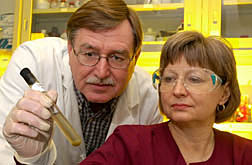This page has been archived and is being provided for reference purposes only. The page is no longer being updated, and therefore, links on the page may be invalid.
Read the magazine story to find out more. |
|
Microbes Strengthen Inside Animals' Protozoa
By Luis PonsFebruary 2, 2006
In an animal research "first," disease-causing bacteria have been found to gain strength from interaction with single-celled organisms called protozoa that are naturally present inside animals. This finding suggests that the protozoa in animals' digestive tracts may be a place where dangerous bacteria can lurk and develop.
In studies at the Agricultural Research Service (ARS) National Animal Disease Center (NADC) in Ames, Iowa, veterinary medical officer Steven Carlson and microbiologist Mark Rasmussen discovered that an antibiotic-resistant strain of Salmonella becomes especially virulent when tucked inside protozoa in the rumen, or first stomach, of cattle.
Until now, protozoa had never been thought of as reservoirs of disease in animals, according to Rasmussen.
|
The researchers set out to study the relationship between rumen protozoa and Salmonella's virulence and resistance to antibiotics. They focused on an S. enterica strain named DT104 that's a foodborne pathogen believed to be more virulent than its antibiotic-sensitive counterparts.
In animals, salmonellosis is usually a diarrheal disease that the animals recover from without requiring antimicrobial therapy. But antibiotics are needed when severe diarrhea or systemic infections occur. Unfortunately, many Salmonella strains have become resistant to many antibiotics, according to Carlson.
The strengthening of disease-causing bacteria as they occupy protozoa is a process that's been seen with free-living protozoa in places such as water-cooling towers and ponds, according to Rasmussen. This strengthening process was discovered when it was linked to an infamous and deadly 1976 outbreak of Legionnaires' disease. But the recent study marks the first time the process has been seen inside an animal, Rasmussen added.
Carlson and Rasmussen also found a way to combat DT104 by using a cleansing process, called "defaunation," which rids the rumen of protozoa.
Postdoctoral molecular biologist Zoe McCuddin and microbiologist Sharon Franklin assisted with this study. All of the researchers in this study work in NADC's Pre-Harvest Food Safety and Enteric Diseases Research Unit.
Read more about this research in the February 2006 issue of Agricultural Research magazine.
ARS is the U.S. Department of Agriculture's chief scientific research agency.


